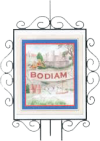Bodiam is a small parish (649 hectares) lying between the north bank of the river Rother and the Kent Ditch in an area of Outstanding Natural Beauty. There are 150 households, the main concentration of population being in Levetts Lane. The first Parish Council meeting, which lasted for forty-five minutes, was held in the National School room on December 4th 1894, when five councillors and a District Councillor were elected. Present day meetings last considerably longer and are held in the Parish Room, which is provided by the Parker Ashcombe Trust. Other public buildings in the parish are St Giles’ Church, Bodiam CE Primary School, Bodiam Manor School, the Castle Inn and Bodiam Castle, a National Trust property since 1925. Apart from the Castle and the Church, there are 15 listed buildings in the parish. The Castle attracts approximately 160,000 visitors a year to the village, some of them arriving on the Kent & East Sussex Railway trains, and a few on the tourist boat from Newenden, but the majority by road.
To see the boat arriving reminds us that the river was once a vital form of communication. There is evidence of settlements here from very early times, both iron age and Roman remains having been found. It is thought that the Roman road to Rochester crossed the Rother somewhere near present day Bodiam bridge, and that there was a river port on the south side at that time probably used for the export of iron ore.
In medieval times the manor house was probably on the hillside above the site of the Castle. However, in 1385, Sir Edward Dalyngrigge, the owner of the estate through marriage to Elizabeth, heiress of the Wardeux family, was granted a licence by King Richard II to “strengthen and crenellate” his manor “for defence of the countryside”. Sir Edward had fought very successfully in the Hundred Years War in France with Sir Robert Knollys, and decided on a more strategic position near the river, which was navigable to Bodiam Bridge. Although there was a possible threat of invasion by the French via the river at this time, he seems to have wanted to combine providing defence of the realm with having an imposing, comfortable residence that would impress the Court. He built the castle that we know today.
Unfortunately we do not know it as he and his family lived in it. At some time during the Civil War it was probably dismantled by Parliamentary forces, and was not rebuilt. Although the walls and towers remain, the interior is a shell. It was owned by a number of families in the intervening years, notably John Fuller who bought it in 1829 to prevent its demolition and George Cubitt, Lord Ashcombe, who purchased it in 1864 and began the first repair work. His son sold the property to Lord Curzon in 1916. Lord Curzon then undertook extensive excavation and restoration, and bequeathed the Castle and the estate to the National Trust on his death in 1925.
Today visitors can enjoy the Castle with its moat and wonderful reflections, and the grounds, included in which is a reminder of World War 2, in the form of a pill box which has recently been restored. This formed part of an inland line of defence against invasion. For many years, most of the land apart from that owned by the National Trust in Bodiam was owned by Messrs Arthur Guinness, and cultivated for hops. Guinness farmed approximately two thousand acres in the local area for around 69 years from 1907 to 1976 and employed 90% of Bodiam adult residents. The hops were hand picked until the 1960’s when picking machines were introduced. Guinness also started a dairy herd using land which was no longer suitable for hop growing. It was decided to grow hops in Bodiam because of the micro climate and ready water supply. Surprisingly the amount of string used each year to string up the hops would stretch from Bodiam to New York. Levetts Lane was built for the employees and was jointly funded between the District Council and Guinness. When the company sold the land in 1976, a great change of land use began, which continues to the present day.
